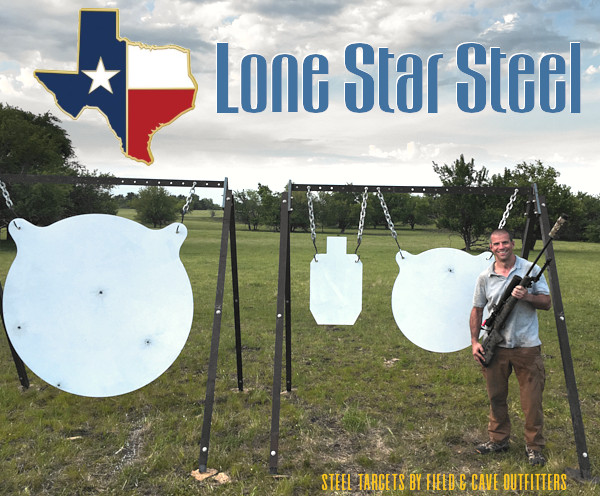ELR Steel Shooting with Field & Cave Outfitters

These targets were set at one mile (1760 yards). Travis Frazer (with rifle) and friend Curtis went a combined 5 for 5 at this distance.
They say that “Everything is Bigger in Texas”. Well that’s apparently true, at least when it comes to steel targets — really BIG steel targets. Our friends at Field & Cave Outfitters (FCO), based in Mesquite, Texas, recently delivered a trailer-load of super-sized steel targets to a large ranch. The Field & Cave team placed a total of 117 steel targets on 34 frames at distances from 25 yards to 1760 yards (one statute mile).

It took Field & Cave Outfitters a big trailer to haul 117 steel targets.
Naturally, after setting the targets up (on 34 frames), Travis Frazer and buddy Curtis Attaway tested the steel — with considerable success. In fact, Travis and Curtis managed to go five-for-five with the One Mile targets. That’s mighty impressive when you consider neither man had ever shot past 1200 yards before. Travis provides a yardage-by-yardage account of his Steel Shooting Adventure below. Enjoy!

Along with the jumbo-sized targets for Extreme Long Range (ELR), Field & Cave Outfitters supplied numerous smaller gongs and plates for shorter distances, starting at 25 yards.
Building a Rifle Shooter’s Paradise and Ringing Steel at One Mile
By Travis Frazer, Field & Cave OutfittersFriend and gunsmith Johnathon Stigall of Crimson Accuracy introduced me to a customer looking to build a private range on his very expansive ranch. Curtis Attaway, a fellow shooting nut, served as facilitator for the ranch owners who ordered a vast array — 117 steel targets and 34 frames to be set up from 25 yards to a full mile. The largest was a 63″-diameter round gong cut from 3/8″ A46100 armor to serve as a One Milliradian-sized target at one mile. (Meaning the diameter of the target equals 1 Mil at 1 Mile.)
“What do you get the guy that has everything — several sections of land, a range out to one mile? Lots of steel, naturally. We delivered 117 steel targets and 34 frames!” — Travis Frazer
After about eight weeks of production time, we delivered and set up the targets in late April 2019. Upon arrival at the property, Curtis and I met the ranch manager and two hands. Luckily we had a tractor, truck, trailer, and mobile power — all the tools necessary to get things done. We worked from 10:00 am to 6:30 pm and only managed to get the long-range rifle targets set. We put steel at 200, 300, 400, 500, 600, 750, 1000, 1100, 1320 (3/4 mile), 1450, 1600, and 1760 yards (1 mile). All the targets were accessible from the same elevated shooting position on the side of a hill.

Shooting Steel from 200 Yards to One Mile
Luckily, after the work was done there was still some daylight left. Optical conditions were near perfect and the wind, while still pretty stiff, had come around to straight out of 6 O’Clock. Curtis brought his 6.5×55 Swede and 28 Nosler. I brought my 6.5×47 Lapua hunting rifle. We took turns shooting — Curtis was prone on his UTV trailer, I was lying in the bed of my truck. We started at 200 yards, each shooting a single round at a steel torso silhouette. We continued taking one shot per distance, making adjustments to what our ballistic APPs suggested, based on the observed impacts on the targets. We continued scoring first-round hits until we reached one thousand yards. After a few shots, getting centered at 1K, we continued on, hitting more than we missed.

I ran out of elevation trying to engage the 1450-yard target. I needed 67 MOA of “up” and only had 60. After three shots and zero hits with varying amounts of hold-over on a Full Scale IPSC torso, I called it quits with the little 47.
Meanwhile, Curtis put a 195gr Berger out of his 28 Nosler on a half-inch-thick AR550 torso at 200 yards to confirm his zero and stress-test the steel. Both passed with flying colors. After that, it was straight to 1100 yards where he scored a first-shot hit, then followed it up with a second shot about two inches to the right. He continued to walk it out, scoring a first round hit at 1320 then 1600. We couldn’t see the hit at 1600 because a tree line obscured the lower third of the 58″ diameter gong. We only knew he hit it because of the glorious ring!
Knowing that he hit it low, Curtis dialed up to one mile, but ran out of travel three minutes short. He backed the power down to 24X so his reticle would subtend properly, held the three minutes and let one fly. He was rewarded with a first-, second-, and third-round hits — the third being almost perfectly centered on the 63-incher. He let me get behind the trigger and told me where to hold. I hit the 63″ gong on the first try, so I decided to give the smaller, half-Mil 37″ target a shot.
That two and a half-second flight time seemed like an eternity. I had resigned to the fact that I missed… but then I saw the 37″ plate swing with the impact. Incredible! The impact was centered horizontally, about 10″ below the top edge (see top photo). That Crimson Accuracy-smithed 28 Nosler made two newbies look like old pros at ELR. The ranch manager watching through the spotting scope couldn’t believe what he was seeing. What he didn’t know is that neither could we!

For more information on these steel targets, visit FieldandCaveOutfitters.com. You can also post questions for Travis Frazer on this AccurateShooter Forum Thread.
























